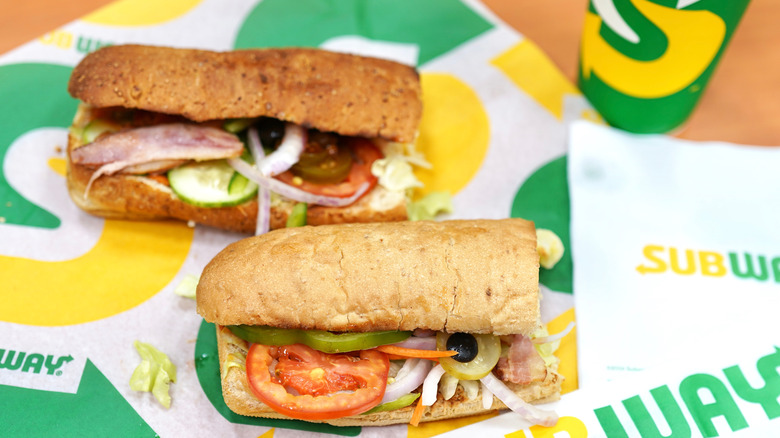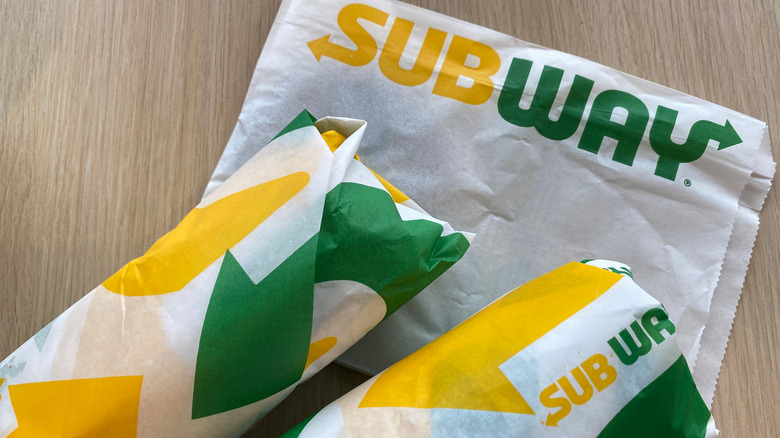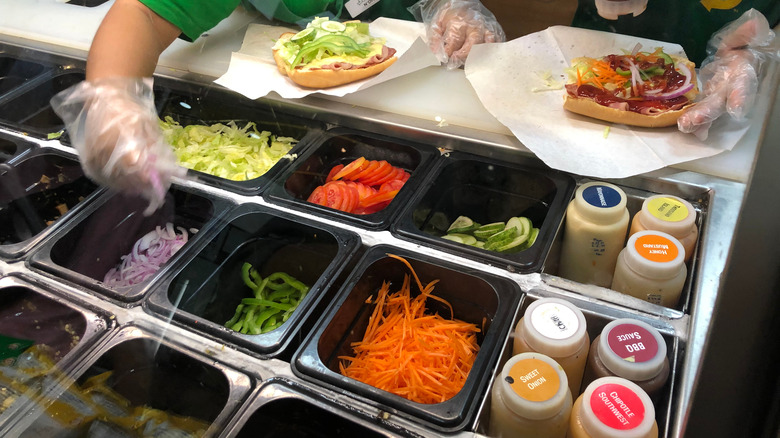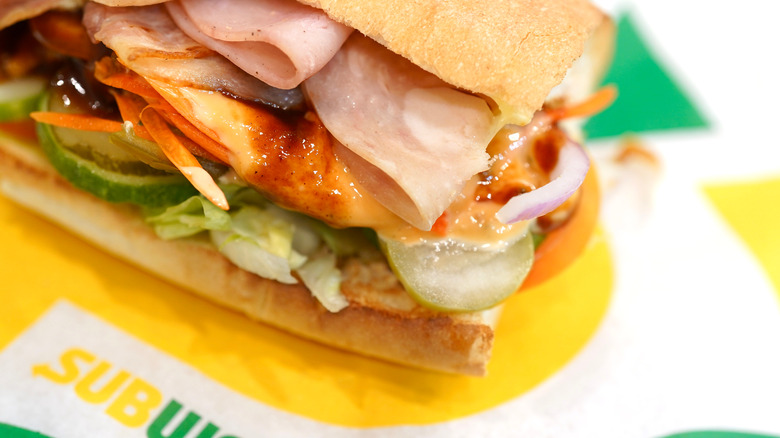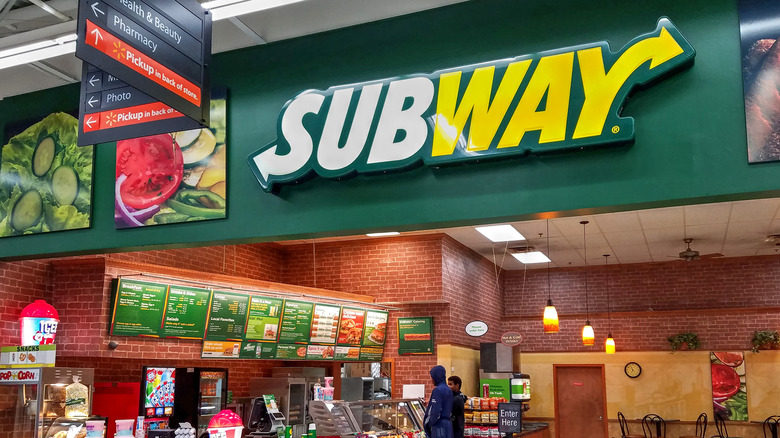Why You Might Want To Think Twice About Ordering Subway's Italian B.M.T.
Fast-food sandwich chain Subway is incredibly popular and found in hundreds of cities. In 2002, Subway beat out other popular fast-food franchises like Starbucks and McDonald's to become the largest fast-food chain in the United States, counted by highest number of individual outlets, per Britannica. It's easy to see why millions of people stop in for sandwiches.
But lately, things have been changing for Subway. According to the Washington Post, in 2021, Subway's domestic sales went down by 3%, which was a larger nosedive than any other of America's top 25 fast-food chains. This represents a $400 million loss in revenue, and Subway fell from No. 1 to No. 3 on the list of top-selling fast-food chains.
One of the most popular sandwiches at Subway is the Italian B.M.T., which stands for "biggest, meatiest, tastiest." Back when Subway was established more than 50 years ago, The Daily Meal reports that the name originally came from an old New York City subway line. But today, that route would include the B, D, F, M, Q, R, J, and Z trains. Thankfully the name stayed the same; "Italian BDFJZLMNRQ" just doesn't roll off the tongue.
The quality and flavor may be lacking
According to Fast Food Nutrition, the Italian B.M.T. is one of Subway's most popular sandwiches. The base of the sandwich is centered on spicy pepperoni, Genoa salami, and Black Forest ham and is able to be customized with any of Subway's cheese, veggies, and sauces, per the Subway menu. But before you take the plunge into the six pepperoni, six salami, and four ham slices, according to Reddit, you might want to pump the breaks and take a peek at the nutritional information. According to the description on the Subway website, a footlong is just over the total daily recommendation for sodium and over half the recommendation for saturated fat.
This might not seem like much of a deciding factor, but as Lucien Formichella for Insider says, "This was a well-rounded sandwich, though the meats weren't great. The salami was a little weird — spicy, but in the blandest way — and the ham got lost at sea." That lackluster assessment of Subway's Italian sandwich has been echoed elsewhere, too. If the sandwich is mediocre-tasting and not the best nutrition-wise, it might not be the best option on the Subway menu.
Subway has faced quality issues in the past
The Italian B.M.T. isn't the only Subway menu item whose quality has come into question. A court in Ireland ruled in 2020 that Subway's bread can't legally be called bread, per The Independent. The ruling found that the "bread" doesn't fall into the legal definition set forth by the Value-Added Tax Act 1972, which says that ingredients like sugar, fat, and dough improvers must not exceed 2% of the total weight of the flour. (For reference, Subway's "sandwich foundations" clock in at about 10% sugar.)
Even if you're a fan of Subway's bread, the sandwich fillings might turn you off from ordering it. As Business Insider uncovered, many Subway locations only receive produce once per week, with one franchise owner comparing the lettuce to "shredded paper." The franchisee added that she used to source produce locally with daily deliveries, but Subway forced her to stop and adopt a cheaper model. Another former employee told Business Insider, "About half of the vegetables we used were far from fresh. I've personally tasted the ingredients by themselves and they DO NOT taste how you'd normally expect them to."
The meat at Subway isn't much better, either. A DNA test done by CBC Marketplace found that a sample of Subway's oven-roasted chicken was only 53.6% chicken, and the chicken strips were a meager 42.8% chicken, with soy comprising the rest of the total.
Subway might not be as healthy as it seems
Even though Subway is definitely fast food, the company tries to market its brand as a "healthier" option. But many of Subway's popular menu items clock in at or over the average daily recommendations for macronutrients like fat and sodium.
A six-inch Spicy Italian sub, for instance, clocks in at 1,280 milligrams of sodium, per Subway's official nutrition info. And the Chicken and Bacon Ranch sub, which Business Insider ranked as the number-two unhealthiest sandwich at Subway, lives up to that ranking. A six-inch of that sandwich includes 1,200 milligrams of sodium and 11 grams of saturated fat. (For reference, a Big Mac also contains 11 grams of saturated fat, along with 1,010 milligrams of sodium.)
In 2016, Business Insider put the Subway diet to the test but found that the sandwiches from the Fresh Fit menu were lacking without the tantalizing high-fat and high-sodium choice. Though the author was able to complete an entire week of the Subway Diet, they also deemed it "impossible."
Location closures
With reports about Subway's freshness and quality slipping, the chain's business success seems to be taking a noticeable dive. CNN reports that in 2016, Subway closed more locations than it opened, contributing to Subway's loss of 359 stores overall. 2017 didn't bode much better; according to Insider, Subway closed another 909 stores, more than 3% of the stores left from the 2016 closures.
Some outlets, like the New York Post, report that one of the possible reasons for this drop in revenue is Subway's Hail Mary attempt to compete with fast-food giant McDonald's by bringing back the $5 footlong promotion. The infamous promotion caused an uproar with franchise owners, who were concerned that offering such a popular discount would cut down their already decreased profits. In fact, 400 owners signed a petition to block the promotion from being rolled out, per the Post.
However, Subway still boasts about 40,000 stores worldwide, per an August 2021 Forbes report. While some fans may not love Subway's sandwiches and vegetables, plenty of others enjoy the chain's offerings just fine.
